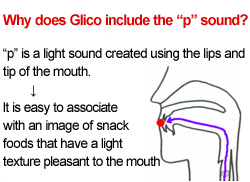Top>Opinion>A Linguistic Analysis of Products that Rely on Naming
 Index
Index

Asako Iida [profile]
A Linguistic Analysis of Products that Rely on Naming
Asako Iida
Professor, Faculty of Commerce, Chuo University
Area of Specialization: Cognitive Linguistics
Analysis of "naming" from a linguistic point of view
My area of specialization is cognitive linguistics, namely cognitive semantics, and I am engaged in research concerned with the meanings and usage of languages such as Japanese and English. In addition to my research on how to count things (Japanese numeratives), I am also interested in "how people perceive objects and express those perceptions in the form of specific language." Currently I am also involved in studies of product naming, while offering a basic seminar in the Faculty of Commerce entitled "Research on Product Names to Attract Consumers".
I have found that there are a large variety of product name strategies based on the "mechanisms of language", such as the subconscious language awareness of consumers, sounds and notation, and emotional perceptions of meaning. I think they are all explained on the platform of cognitive semantics.
Glico's "P-sound" strategy for product names
The sounds included in product names play an important role in selling those products. For example, Glico's products include "Pocky", "Pretz", "Pucchin' Pudding", "Papico", "Poscam", "Pakitz", "Panapp", and "Almond Peak", all of which contain the "P" sound within their names.
When the "P" sound is made, we lightly touch our top and bottom lips together in order to create the sound (bilabial sound.) This action resembles the movement of the mouth when crunching on food, and has the effect of creating an association with a crispy snack that has a texture pleasant to the lips and mouth.
| Product names with the "P" sound at the beginning of and within the word | Product names with the "P" sound within the word |  |
| Pocky | Caplico | |
| Pretz | Zeppin (curry roux) | |
| Pucchin' pudding | Curry pot | |
| Papico | Almond premio | |
| Panapp | Almond peak | |
| Poscam | Ta pasta | |
| Palitte | | |
| Pakitz | |
Manipulation of the images and subconscious awareness evoked by sound is known as "sound impression". Many product names are specifically created to aim for and utilize the effects of sound impression. We may say Glico is making full use of this effect in selling their products.
Momoya's "Taberu raayu", which made name length work for it
"Taberu raayu" ("Chili oil for eating"), has become so popular among young people that it is now abbreviated to simply "Tabe-raa". It is said that a product from the Momoya company first sparked this explosion in popularity.
If we paid no attention whatsoever to product names while shopping, Momoya would probably have named this product simply "Raayu" ("Chili oil"). However, they wanted to make it clear that this chili oil had other ingredients in it, and so added the phrase "gu-iri" ("with ingredients") to its name, as in (2). On the other hand, they also wanted it to appeal to people who don't care for spicy foods, so the phrase "karasou de, karaku nai" ("looks spicy, but isn't") was added as in (3). Together with the previous "gu-iri" phrase, the full name became "Karasou de, karaku nai, gu-iri raayu" ("flavored oil with ingredients that looks spicy, but isn't"), as in (4).
| (1) Display the product name alone | (2) Include the product's characteristics | (3) Aim for an expanded target range | (4) Include additional information | Actual product name |
 |
 |
"Karasou de, karaku nai raayu" (Chili oil that looks spicy, but isn't) | "Karasou de, karaku nai, gu-iri raayu" (Chili oil with ingredients that looks spicy, but isn't) | "Karasou de, karaku nai, sukoshi karai raayu" (Slightly spicy chili oil that looks spicy, but isn't) |
| The name, which at first appears contradictory, piqued the interest of consumers and became a hit. | ||||
However, the name "Karasou de, karaku nai, gu-iri raayu" ("Chili oil with ingredients that looks spicy, but isn't") ultimately has the meaning "not spicy after all", and it was feared that this would deviate from the original development intentions. Momoya's strategic answer to this was to insert the phrase "sukoshi karai" ("slightly spicy"). The name "Karasou de, karaku nai, sukoshi karai raayu" ("Slightly spicy chili oil that looks spicy, but isn't") prompted exasperated consumers to unconsciously exclaim "Well, which is it then, spicy or not spicy?!".
This in turn ignited the desire for those consumers to search for the product on the Internet, or to pick up a jar from the market and find out for themselves once and for all.
Naming for good luck to attract test-taking students
When test-taking season comes around, many snacks and food products intended to encourage test-taking students make an appearance along with it. One representative case is Meiji's "Kaaru" ("Karl"). In test-taking season, a "u" is added to this product's name to make it read "Ukaaru" ("ukaru" meaning "to pass a test"). "Hairemon" ("Hi Lemon"), made by the same company, also undergoes a metamorphosis by having a "ru" sound inserted into its name, making it "Hairerumon" ("haireru" meaning "to be able to enter (a school)"). In terms of product promotion, such methods can be considered an extremely efficient linguistic strategy. Adding a single letter lets them enhance the value of their products.
Lotte also changes their "Toppo" product to "Toppa" ("toppa" meaning "to break through (an obstacle)") for this season. Just by changing an "o" to an "a", an auspicious name to attract test-takers is born. In addition, "Kishiritooru Gum" ("Xylitol Gum") changes its "Kishiritooru" to "Kicchiritooru" ("kicchiri tooru" meaning "to pass without fail"), to create a name suggesting an improvement in studying efficiency by chewing it.
| Actual product name | Product name oriented to test-takers |  Stores become packed with products renamed to encourage test-takers. |
| Kaaru ("Karl"), (Meiji) | Ukaaru ("ukaru" meaning "to pass a test") | |
| Hairemon ("Hi Lemon"), (Meiji) | (Hairerumon) ("haireru" meaning "to be able to enter (a school)") | |
| Toppo, (Lotte) | Toppa ("toppa" meaning "to break through (an obstacle)) | |
| Kishiritooru Gum ("Xylitol Gum"), (Lotte) | Kicchiritooru Gum ("kicchiri tooru" meaning "to pass without fail") | |
| Karupisu ("Calpis"), (Calpis) | Ukarupisu ("ukaru" meaning "to pass a test") | |
| Mori no Tamago ("Eggs of the Forest"), (Ise Foods, Inc.) | Mori no TamaGoukaku ("goukaku" meaning "to pass a test") | |
| Kafe Ore (Caf辿 au Lait), (AGF) | Kate Ore ("kate" meaning "go-win") |
Other long-selling products from various companies also see increased sales during test-taking season compared to normal periods, just by using a little ingenuity to rename products with sounds and vocabulary that suggest good luck for test-takers. This might even be referred to as corporate "semantic strategy".
As described above, the names of many products that we come across in daily life without giving them a second thought actually employ various linguistic strategies. Here, I have touched on 3 examples: (1) Glico's sound-based strategy, (2) Momoya's text-based strategy, and (3) the meaning-based strategy found in products oriented to test-takers. My new book "Naming Talks" introduces many more examples like these, so please give it a look if you have the chance.
- Asako Iida
Professor, Faculty of Commerce, Chuo University
Area of Specialization: Cognitive Linguistics -
Born 1969, Tokyo. Area of specialization: Cognitive Linguistics. After graduating from Tokyo Woman's Christian University, completed master's program at Graduate School of Letters, Keio University, in 1995. In 1999, completed area of specialization in Linguistics at Graduate School of Humanities and Sociology, the University of Tokyo. Ph.D. Thesis: A Descriptive Study of Japanese Major Classifiers (1999), the University of Tokyo, Faculty of Literature (Linguistics), Tokyo.
After obtaining positions as full-time lecturer and assistant professor at Chuo University, has held current position from 2009. - Member of "Tokyo Sky Tree" Name Review Committee. Also involved in naming of "Middle Bridge" at Chuo University's Ichigaya Tamachi campus. Currently presenting seminars on product names and advertising copyies? Catch phrases? at the Faculty of Commerce. Main literary works include The Dictionary of How to Count Things [Kazoekata no Jiten], Esprit of Counting Things [Kazoekata mo Hitoshio] (both Shogakukan), and Brushing up your Japanese with How to Count Things [Kazoekata de Migaku Nihongo] (Chikuma-shobo). Latest publication is Naming Talks: from "That Hit Product" to the "Tokyo Sky Tree" [Neemingu ga Mono wo Iu: Ano Hitto Shouhin kara "Toukyou Sukai Tsurii" made] (Chuo University Press).
- Research Activities as a Member of Research Fellowship for Young Scientists (DC1), Japan Society for the Promotion of Science (JSPS) Shuma Tsurumi
- Important Factors for Innovation in Payment Services Nobuhiko Sugiura
- Beyond the Concepts of Fellow Citizens and Foreigners— To Achieve SDGs Goal 10 “Reduce Inequality Within and Among Countries” Rika Lee
- Diary of Struggles in Cambodia Fumie Fukuoka
- How Can We Measure Learning Ability?
—Analysis of a Competency Self-Assessment Questionnaire— Yu Saito / Yoko Neha - The Making of the Movie Kirakira Megane








